Solana's liquid staking transforms holdings into liquid assets, allowing for efficient utilization and higher returns through the Sanctum platform and DeFi applications.
Author: Algo Rhythmic
Translation: Blockchain in Plain Language
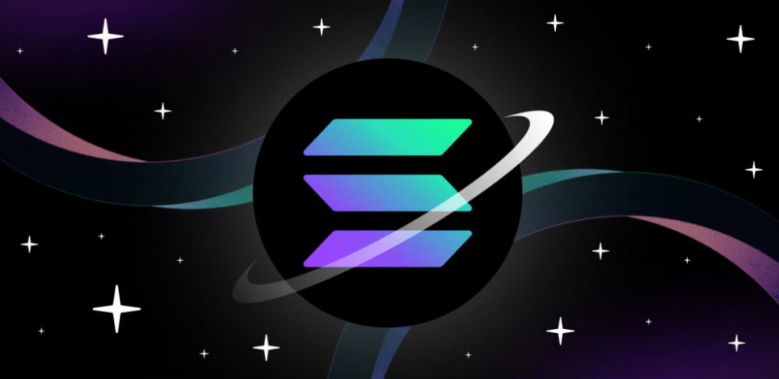
My goal is to provide a comprehensive introduction to Solana's liquid staking. I want everyone to not only understand what liquid staking is and how to do it, but also to understand why it should be done. What makes someone wake up in the morning and say to themselves, "Today I'm going to stake my SOL for liquid staking? Come on, join me, and I'll take you into a whole new world."
I will also try to structure this rather long article so that you can skip certain parts if you are already familiar with the topic. Based on this, here is the table of contents:
Staking on Solana
LSTs and Continuous Risk
Leading LSTs and Their Incentive Structure
Sanctum and the Future of Infinite LSTs
How to Liquid Stake
LSTs and Decentralized Finance
Conclusion
Note: This article is for educational purposes, not investment advice.
1. Staking on Solana
Before we discuss liquid staking directly, let's first understand the conventional staking. In proof-of-stake (POS) networks like Solana, staking involves delegating your tokens to a validator who must commit to faithfully validating transactions on the network, or else face penalties. This fundamental consensus between validators and network users is essential to prevent double spending, censorship, and various other abuses. When you stake "locally," you choose a specific validator and delegate your tokens to them. This can be done through a series of wallet software or using the Solana command-line interface.
Since the launch of the Solana mainnet test version in February 2020, Solana has been following this proposed inflation plan:
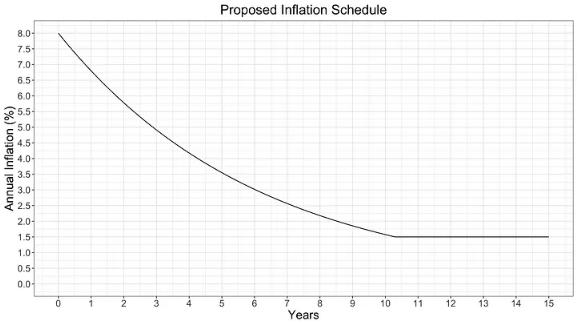
As I write this article, it is already February 2024, four years since the launch, so it is easy to see that the current inflation rate is about 5%. The precise inflation amount is controlled by three parameters: initial inflation rate (8%), deflation rate (-15%), and long-term inflation rate (1.5%). The inflation rate starts at 8% and decreases at a rate of 15% per epoch boundary on an annualized basis until it stabilizes at 1.5%. This may change in the future, but this is the plan observed since the launch.
Who owns the SOL tokens generated through inflation? Quite simple: the stakers. This means that in each epoch, stakers are increasing their relative ownership of SOL tokens in a way that sacrifices non-stakers. In reality, nothing more complex is happening. If all SOL were staked, no one would be increasing their holdings' total value. This results in a high staking rate on the Solana network; at the time of writing, approximately two-thirds of SOL is staked. However, the proportion of liquid staking is still relatively low.
For proof-of-work (POW) blockchains, validators bear high equipment and energy costs, forcing them to sell some (or possibly all) of the tokens they receive just to break even. In proof-of-stake networks like Ethereum, these costs are very low, so there is almost no selling pressure. On Solana, the operating costs of validators are slightly higher than Ethereum because validators must execute transactions as part of the consensus, incurring costs, and the cost of validator equipment is slightly higher than Ethereum because it requires higher performance. Therefore, compared to Bitcoin, the selling pressure from validators is still very low, but slightly higher than Ethereum.

Translation: I think "Solana's cheap transactions are artificially subsidized through token inflation" has become a bloody slander against Solana. CT has learned some knowledge about inflation from Bitcoin, and now we can't forget it. There is no strong buying and selling pressure
Now let's talk about Liquid Staking.
2. LSTs (Liquid Staked Tokens) and Continuous Risk
There are high incentives on Solana for staking to avoid dilution by other stakers. One of the few reasons not to stake is that it locks your capital in each epoch. Through liquid staking, you contribute your tokens to a pool that manages the staking of tokens allocated by validators and tokenizes the fact that you have already committed tokens to the pool. This action returns a new asset representing this fact to the stakers and allows users to exchange it for the original staked SOL. Therefore, in many cases, it can be used as a functional equivalent of SOL.
The most popular liquid staking tokens (LST) on Solana are almost always "rewarded" tokens. Almost all SOL in the pool is delegated to validators selected by the pool operator (sometimes minus a small buffer for quick redemption), so these delegated SOL in the pool accumulate rewards in the form of more SOL. As a result, the quantity of LST continues to increase over time, but the amount of SOL it represents in each epoch increases, causing its price relative to SOL to rise. Another method is "rebasement," where LST holders receive more liquid tokens, each of which can be exchanged 1:1 (with a delay), but this is not common on Solana.
On Solana, each epoch lasts approximately 2.5 days. If a user wants to reclaim the original staked SOL, they must submit a request to withdraw the staked tokens and wait for the epoch to end before they can redeem them. In traditional financial markets, this is known as bearing continuous risk. You are betting that the reward for locking up capital for 2.5 days will outweigh the risk of needing it immediately. In terms of duration, the 2.5-day risk is much smaller compared to a 10-year U.S. Treasury bond. On the other hand, overall, U.S. Treasury bonds… have less volatility than cryptocurrencies.
Therefore, when LST holders want to obtain the underlying SOL tokens, they can redeem them from the staking pool controlled by the Liquid Staking protocol, choose to wait for the end of the epoch when it can be undelegated from the underlying pool, or trade mSOL for SOL on the open market through existing liquidity pools. Here is an example from Marinade Finance:
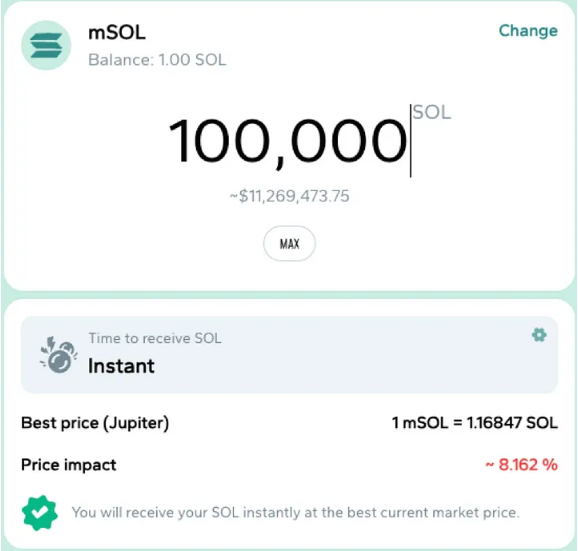
Marinade uses the Jupiter decentralized trading aggregator to trade mSOL for SOL. I did some checks and found that withdrawing a delegation of 10,000 mSOL would have a 0.01% impact on the price, but when the delegation amount increases to 100,000 mSOL, the displayed price impact is 100,000 (I don't actually have that much mSOL, but it can be simulated). What does this mean?
This means that if you want to withdraw the delegation and immediately obtain SOL, you will receive 8.162% less SOL than waiting for the end of the epoch to withdraw the delegation. The price impact mentioned above is determined by current market conditions, depending on the liquidity situation. This highlights an important fact about LSTs. As I mentioned earlier, they can act as a functional equivalent of SOL in many scenarios, but one important distinction is that you will bear a certain level of continuous risk. If you need funds urgently and in large quantities, you will have to accept a lower price to obtain the required funds.
A simple example can help understand this. Let's look at the "mSOL decoupling" event that occurred on December 12, 2023. In just 20 minutes, a wallet address 85b5jKkgSuopF3MUA9s4zsBhRANrererBLRx689PqTPA exchanged approximately 68,536 mSOL for SOL in about 9 transactions on the open market. This caused the price of mSOL to drop from about $78 to $66. Here is an analysis from birdeye.so:
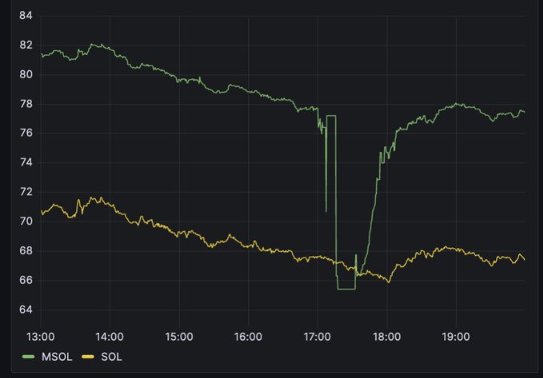
You can see that the price quickly recovered to its previous level. Why did this happen? Because arbitrage bots and other speculators noticed this opportunity and started buying mSOL, as they did not need this capital in the next epoch. The price of the underlying SOL did not actually change, so they were essentially buying discounted SOL.
This situation is not limited to mSOL and applies to every LST (with some additional conditions we will discuss later). The liquidity of any specific LST will inevitably be lower than that of SOL tokens. However, this is mainly a concern when you have a large amount of liquid staked SOL. Overall, having more funds also means facing more challenges.
Therefore, the lesson here is that while liquid staking tokens bear some continuous risk similar to regular staked SOL, it only becomes apparent when there is insufficient liquidity in the market. The stronger the liquidity in the LST market, the smaller the impact of continuous risk. If your holdings are relatively small, you may not feel this continuous risk at all. Nevertheless, understanding the liquidity constraints of tokens is still very important.
3. Leaders in LSTs and Their Incentive Structure
There are three LSTs on Solana with a total locked value of over $100 million, highlighting different adoption incentives: Jito (jitoSOL), Marinade (mSOL), and BlazeStake (bSOL). This may change, but you can see approximate numbers here:
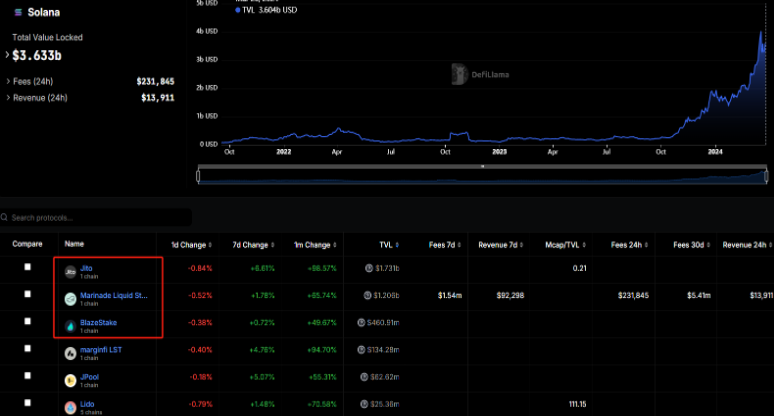
https://defillama.com/protocols/Liquid%20Staking/Solana.
Currently, Jito is in the lead, so we will start with it.
1) Value Proposition of Jito
The Jito protocol invites stakers to join the ranks of earning MEV on Solana and offers rewards for minting JitoSOL. JitoSOL is achieved through a secure SPL Stake Pool, with optimized validator groups and MEV distribution. The protocol supports efficient transaction processing through the Jito-Solana client and plays a crucial role in Solana DeFi. The use of JitoSOL can earn points in the growing Solana ecosystem and provide competitive returns and performance, offering a unique staking experience for the community.
However, a real distinction lies in the maximum extractable value (MEV). In short, MEV allows traders to extract value from transactions, but Solana's design makes MEV more difficult to extract. Jito creates a more orderly and accessible environment for the MEV market by modifying Solana Labs' validator software to increase the ability of validators to accept ordered transactions and charge for them. Staking SOL in Jito's liquid staking pool can earn a portion of these profits. Other LSTs can also be delegated to validators running Jito-modified validator software to benefit from it.

2) Value Proposition of Marinade
Marinade is the first liquid staking protocol on Solana and leads best practices in the field. When staking directly, you need to choose a validator, but the liquid staking pool automatically allocates you to multiple validators, reducing risk. Last month, Marinade proposed an initiative for validators to create an insurance fund to safeguard the interests of delegators. Additionally, they introduced "Directed Staking" to allow stakers to support specific validators and earn additional incentives. Marinade's governance is conducted through MNDEToken, holders can vote on how the protocol operates, and this token is independent of mSOL. They are currently running a campaign where participants can earn additional MNDEToken as a reward to encourage their support for the protocol's development.

3) Value Proposition of BlazeStake
```
The main difference of BlazeStake is associated with the BLZE governance token. Similar to MNDE, BLZE can be used for voting to decide incentive allocation, but it also has independent value. BlazeStake is a relatively young project, so they have only distributed about 80% of the total supply of tokens, while Marinade has fully distributed their tokens and must repurchase them to create MNDE token incentives. Depending on your perspective and investment time horizon, this may have both benefits and drawbacks. Jito also has a governance token JTO, but it is not currently used for incentivizing staking with Jito. Let's quickly compare the governance tokens ranking in the TVL of the top three protocols, including market cap, circulating supply, and growth trend:

Data is taken from February 16, 2024, from Defillama, Coingecko, and Birdeye.
BLZE performs well in terms of the total locked value to fully diluted market cap ratio of the governance token. However, several issues need to be noted. Firstly, the high FMDC of JTO is due to the low circulating supply, which may result in FMDC being less accurate in the short term. Secondly, BLZE has only unlocked 2/3 of the token supply, so new tokens will enter the market. To understand the unlocking schedule, please refer to this: https://twitter.com/solblaze_org/status/1688480225255161856.
What are the use cases of BLZE that make it valuable? Similar to MNDE, you can support specific governance proposals through voting to help bSOL achieve its goals. However, BlazeStake adopts a mechanism called Equity Volume Rules, allowing users to control more sustainably and finely. You can choose to vote in the decentralized autonomous organization (DAO) at Realms.today, direct additional equity to specific validators, or direct more BLZE rewards to specific liquidity pools in DeFi. BLZE holders can also lock their BLZE for up to 5 years to increase voting rights in the DAO. Below is a screenshot of the equity volume, showing some example options for directing votes after depositing into the DAO. These features are quite unique in LST.
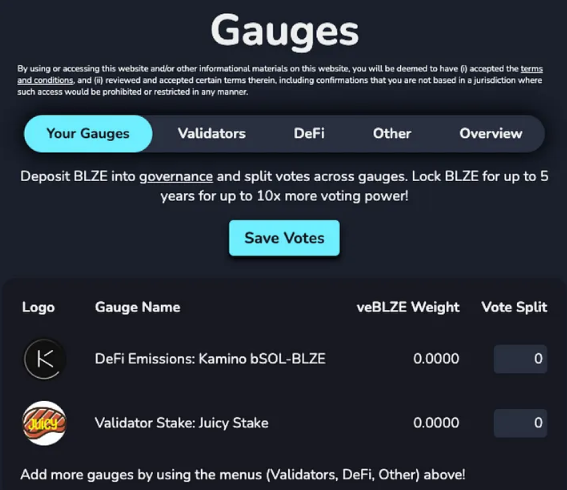
Some DeFi protocols require you to claim BLZE rewards within their interface, and BLZE rewards are airdropped directly every two weeks. You can check your wallet's current SolBlaze score at rewards.solblaze.org. Attempting to artificially inflate the score by creating multiple wallets does not provide a real advantage. The basic formula is: 1 bSOL in your wallet = 1 point, 1 bSOL in a supported lending protocol = 1.5 points, and 1 bSOL in a supported bSOL liquidity provision position = 2 points. This roughly aligns with the risk you take with your capital, so it is reasonable that the higher the risk, the higher the reward.
Another noteworthy feature is that BlazeStake offers an option to stake your SOL with a single validator called "custom liquid staking mining." Unlike Marinade, 100% of the stake will be directly allocated to that validator. It is worth noting that unlike Marinade, which only delegates 20% of the stake directly to the validator of your choice, the remaining 80% is allocated through their delegation strategy algorithm. Marinade details this in their documentation, but it is not immediately apparent in their user interface, which I think is somewhat less than ideal.
BlazeStake also has some other interesting features. They provide a real SOL faucet, meaning if you mistakenly lock all your SOL on their platform and do not have enough SOL to pay the unlocking transaction fee, you can use the faucet to get some SOL to cover the fee. This is very convenient because you do not need to introduce new funds through a centralized exchange. Additionally, they offer a simple token minting user interface that allows you to easily create an SPL token, and provide an RPC status page and SOL Pay SDK. All of these are beneficial features that help promote the concept of SOL and liquid staking mining.
If the main value of BlazeStake comes from the issuance of its governance token, then the price trend of BLZE is the driving factor of value. The price of BLZE started to rise at the end of November 2023 and has remained stable between 0.002 and 0.004 USD, but according to the above data, there may still be significant room for growth. If it can maintain stability like Marinade, there is still 2.8 times room for growth.
In my opinion, the valuation of BLZE should be comparable to MNDE, or even higher. I am not sure how to compare the valuation of JTO with the other two. I like this project, and what they are doing with MEV on Solana is fundamentally unique. I look forward to future innovations, but almost 90% of the token supply is still pending issuance, which seems a bit high. However, the fully diluted market cap is not important… until it is. Anyway, I think all three projects have good opportunities for appreciation relative to the US dollar, as these liquid staking mining protocols are creating value. The simple argument: liquid staking mining is good.
In summary, regarding the three most important liquid staking mining protocols on Solana, they all emphasize the benefits of decentralization on Solana. Liquid staking mining pools distribute stakes to a wide set of validators, rather than creating a winner-takes-all situation. They all openly promote their security. Each Liquid Staking protocol has smart contract risk, meaning there is a risk of errors in the operation of the staking mining pool smart contract, but they all have a trusted security awareness. These are all good things, but they do not really differentiate these three methods, which is why I tried to highlight their unique features in the above text.
4. Sanctum and the Future of Infinite Liquid Staking Mining
There are many other Liquid Staking protocols on Solana, and the number of these protocols is about to increase significantly due to the liquidity support pool that sanctum.so is working hard to advance. Their goal is to provide liquidity to any liquid staking mining protocol and offer SOL exchange services, making any liquid staking mining protocol as liquid as possible. They charge a fee of less than 0.03%, usually 0.01%, which is essentially equivalent to assuming the epoch risk for you. You can immediately exchange your liquid staking mining tokens for SOL, and the pool provides a buffer for this, spreading the epoch risk to a wider range.
As of now, Sanctum supports twelve different liquid staking mining protocols, but their goal is to address the liquidity bootstrapping issue of almost all Liquid Staking protocols. The liquidity of Liquid Staking protocols depends solely on the liquidity available in protocols such as Orca and Radium, so new Liquid Staking protocols often need to devise strategies to boost liquidity to fulfill their commitment. Sanctum provides a huge additional buffer, allowing new and low-market-share liquid staking mining protocols to have immediate liquidity.
As of now, the liquid staking mining tokens that can be exchanged for SOL immediately using Sanctum include: bSOL, cgntSOL, daoSOL, eSOL, jitoSOL, JSOL, laineSOL, LST (Marginfi's liquid staking mining token), mSOL, riskSOL, scnSOL, and stSOL.
Sanctum's universal LSTs liquidity pool makes it possible to conduct larger-scale experiments in the field of Liquid Staking.
5. How to Liquid Stake
Now that you have learned about some options, let's briefly understand how to operate. Taking bSOL as an example, simply go to stake.solblaze.org, click on the "Stake" tab, and the following user interface will appear.
Remember, like most LSTs on Solana, bSOL also generates returns, so the bSOL you withdraw will be less than the SOL you submit. Don't be alarmed by this. In the image, you can see that 0.8993 bSOL = 1 SOL. This is because 0.8993 bSOL represents the claim to the BlazeStake liquid staking mining pool equivalent to 1 SOL, so you won't lose any value. As the amount of SOL held in the liquid staking mining pool grows, this number will continue to decrease, meaning the amount of SOL you receive per bSOL will continue to increase. Currently, 1 bSOL = 1.11 SOL, and this number will continue to rise over time.
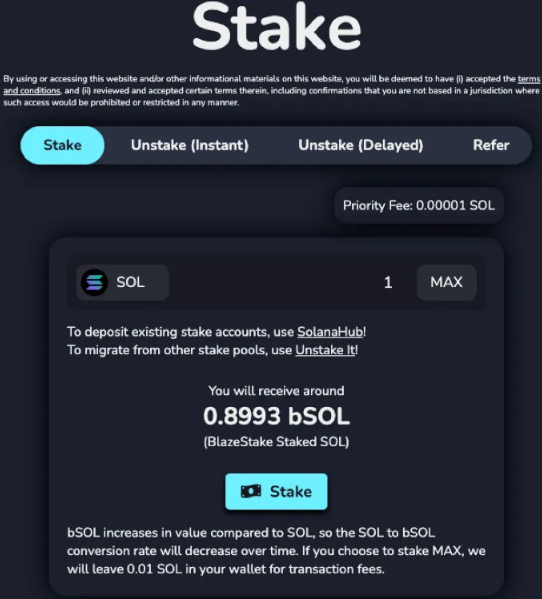
Select the amount, click the button, approve the transaction, and then complete.
6. LSTs and DeFi
Now that we have a fairly good understanding of how LSTs work, know the choices of LSTs and the benefits of different methods, let's take a look at the DeFi options. The purpose of all this is to turn your staked tokens into liquidity so that you can use it for various purposes.
Let's start with something relatively simple, like lending.
Lending
One of the simplest and lowest-risk things you can do with LST is to lend it out. Platforms like MarginFi, Solend, and Kamino allow users to deposit collateral and borrow other assets of their choice. Cryptocurrencies are typically very volatile, so these platforms only offer over-collateralized lending positions. This means that the value of the collateral your counterparty must provide is higher than the assets they borrow. This usually varies based on the assessment of the collateral quality. If the value of the deposited collateral falls below a certain threshold, it will be liquidated and used to repay the borrower.
The rules for this liquidation process are somewhat complex, and different projects take different approaches. If you are investing a significant amount of funds, it is important to understand these rules.
Generally, the annualized yield for LST lending is relatively low because the demand is not very high. The highest, lowest-risk earning opportunities have already been utilized due to the collateral being staked. Nevertheless, you can still lend it out in a relatively safe manner to earn some additional returns, or possibly earn some protocol rewards through lending, so it is an option worth considering.
Looping
Now that we have talked about lending, let's talk about what lending can achieve. Suppose you have 10 bSOL, currently advertised with an annualized yield of 7.34% (remember, this number will vary slightly with each epoch), plus an additional 0.81% annualized yield in the form of BLZE issuance (depending on the price of BLZE). How can you earn more returns? One way is to deposit these bSOL into a lending protocol, borrow more SOL, and then stake that SOL with BlazeStake. Drift Protocol and Kamino Finance offer a simple product to execute this operation with one click and adjustable leverage. You can also manually execute this operation through protocols like Solend. An important variable to note is the SOL lending rate. The higher this rate, the lower your overall annualized yield. Why? Because you have to deduct it as a cost. Here's a quick example from Drift's SuperStakeSOL UI.
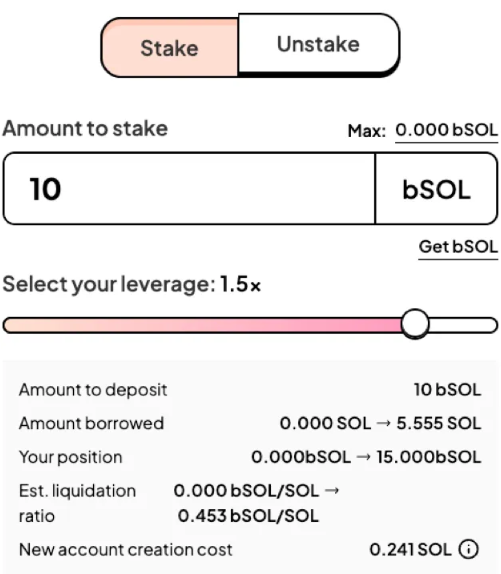
In this example, you use 10 bSOL as collateral to borrow 5 SOL. You have to pay an annualized interest rate of 0.6% to borrow SOL, but you can then stake that SOL with bSOL again and earn additional returns. As long as the lending rate is lower than the rewards, this makes sense. Remember, you are taking on risk here. The main risk is the "unpegging" event of mSOL mentioned earlier. This can happen at any time because the mechanism that links its value to SOL has a time component.
Providing Liquidity
Another way to increase LST returns is by providing liquidity. Liquidity pools underpin decentralized exchanges, allowing you to swap token pairs. If there are enough of these pools, you can swap any asset through a list of pools via cross-pool exchanges. Since USDC and SOL typically have the deepest liquidity, any route usually goes through them. For example, if you want to swap WIF for WHALES, you might first swap WIF for SOL, and then swap SOL for WHALES.
The pool charges a fee for the exchange, which is returned to the liquidity providers (LP). When the trade remains balanced, with the same amount of WIF exchanged as WHALES, the price remains stable, and the LP only collects fees. However, this fee is reasonable because there is a risk of impermanent loss. If demand starts to significantly skew towards WHALES, the amount of WHALES in the pool will decrease, and the amount of WIF will continue to increase until the LPs only hold WIF, and now the value of WIF is lower than before. This trend can obviously reverse, which is why it's called impermanent loss, but it's something to keep in mind.
So, which liquidity pools are attractive for LST? First, the SOL-LST pool is very popular because it supports instant staking and unstaking operations. Secondly, pools of the LST1-LST2 type are also very good because you hold two LSTs, both of which can earn normal staking rewards and also a small portion of trading fees. You know they should be highly correlated in price because they are related to the SOL price (although not pegged). The risk of impermanent loss is very low. Third, for a higher risk, higher return option, you may want to consider pools that allow you to exchange LST for their protocol governance tokens, such as jitoSOL-JTO or bSOL-BLZE. These are usually incentivized with additional governance token rewards to ensure there is reasonable liquidity.
I cannot emphasize enough the importance of understanding the subtle differences in providing liquidity. Different pools have differences in how liquidity is allocated and controlled by LPs. Different approaches work better or worse depending on how tokens are traded, so you need a good mental model to understand how price action will unfold, and thus, you want to place liquidity in pools to achieve consistently good results. For the first two options (SOL-LST, LST1-LST2), your mental model is basically "they will continue to be highly correlated," which makes everything very simple. If you want to delve deeper than simple options, I suggest starting with a small amount and observing how price action unfolds. Note how the balance in the pool changes as assets are traded, how fees accumulate, and decide if it's worth making a larger investment.
Some DeFi protocols, such as Kamino, offer a treasury that automatically manages LP strategies, so you don't have to do much. They come with a pre-built strategy for deploying funds into the liquidity pools they follow. Before doing this, you should understand what it is, but it means you don't have to manually enter the pool and rebalance your range. Of course, they will charge a small fee.
The combination of lending, looping, and providing liquidity does not exhaust your options with LST, but I don't want to turn this into a thesis. If you haven't tried all three options yet, you may want to try them out before delving deeper.
7. Conclusion
I hope this article gives you a solid understanding of Liquid Staking on Solana. The current and future potential of LST and DeFi on Solana is promising, and the pace of innovation in this field is amazing.
If you find any errors in the article that need to be corrected, or if you feel that I have described something incorrectly, I am happy to receive feedback and consider making changes.
The amazing thing about Solana is that you can try all of this with just $10. If you are concerned about the risks involved and whether you understand them enough to try all of this, you can start cautiously and get a feel for it. The only person who can assess your risk tolerance and whether it's worth trying any given opportunity is yourself.
Source: https://medium.com/@brain.eight.cite/liquid-staking-on-solana-c5ee8676dd09
免责声明:本文章仅代表作者个人观点,不代表本平台的立场和观点。本文章仅供信息分享,不构成对任何人的任何投资建议。用户与作者之间的任何争议,与本平台无关。如网页中刊载的文章或图片涉及侵权,请提供相关的权利证明和身份证明发送邮件到support@aicoin.com,本平台相关工作人员将会进行核查。




